Zunlei Feng
Zhejiang University
Reinforced Model Merging
Mar 27, 2025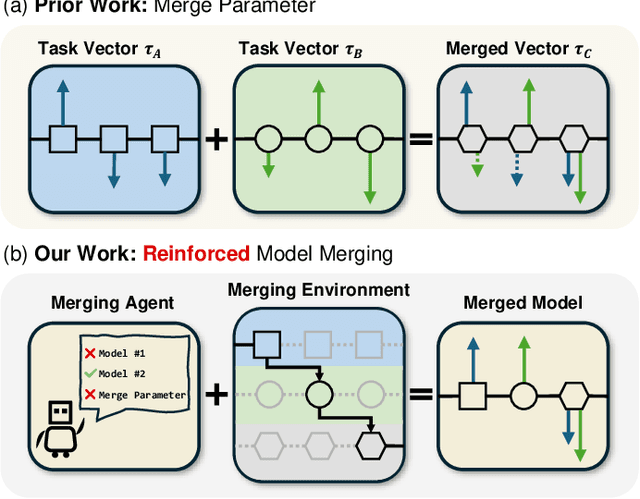
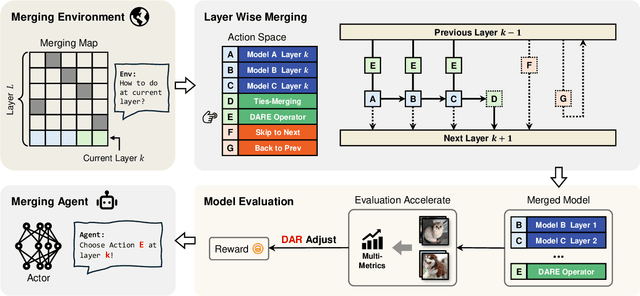
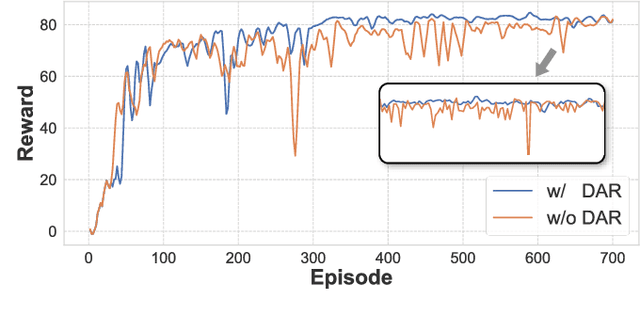

Abstract:The success of large language models has garnered widespread attention for model merging techniques, especially training-free methods which combine model capabilities within the parameter space. However, two challenges remain: (1) uniform treatment of all parameters leads to performance degradation; (2) search-based algorithms are often inefficient. In this paper, we present an innovative framework termed Reinforced Model Merging (RMM), which encompasses an environment and agent tailored for merging tasks. These components interact to execute layer-wise merging actions, aiming to search the optimal merging architecture. Notably, RMM operates without any gradient computations on the original models, rendering it feasible for edge devices. Furthermore, by utilizing data subsets during the evaluation process, we addressed the bottleneck in the reward feedback phase, thereby accelerating RMM by up to 100 times. Extensive experiments demonstrate that RMM achieves state-of-the-art performance across various vision and NLP datasets and effectively overcomes the limitations of the existing baseline methods. Our code is available at https://github.com/WuDiHJQ/Reinforced-Model-Merging.
SHAPE : Self-Improved Visual Preference Alignment by Iteratively Generating Holistic Winner
Mar 06, 2025



Abstract:Large Visual Language Models (LVLMs) increasingly rely on preference alignment to ensure reliability, which steers the model behavior via preference fine-tuning on preference data structured as ``image - winner text - loser text'' triplets. However, existing approaches often suffer from limited diversity and high costs associated with human-annotated preference data, hindering LVLMs from fully achieving their intended alignment capabilities. We present \projectname, a self-supervised framework capable of transforming the already abundant supervised text-image pairs into holistic preference triplets for more effective and cheaper LVLM alignment, eliminating the need for human preference annotations. Our approach facilitates LVLMs in progressively enhancing alignment capabilities through iterative self-improvement. The key design rationale is to devise preference triplets where the winner text consistently improves in holisticness and outperforms the loser response in quality, thereby pushing the model to ``strive to the utmost'' of alignment performance through preference fine-tuning. For each given text-image pair, SHAPE introduces multiple visual augmentations and pairs them with a summarized text to serve as the winner response, while designating the original text as the loser response. Experiments across \textbf{12} benchmarks on various model architectures and sizes, including LLaVA and DeepSeek-VL, show that SHAPE achieves significant gains, for example, achieving +11.3\% on MMVet (comprehensive evaluation), +1.4\% on MMBench (general VQA), and +8.0\% on POPE (hallucination robustness) over baselines in 7B models. Notably, qualitative analyses confirm enhanced attention to visual details and better alignment with human preferences for holistic descriptions.
SecPE: Secure Prompt Ensembling for Private and Robust Large Language Models
Feb 02, 2025Abstract:With the growing popularity of LLMs among the general public users, privacy-preserving and adversarial robustness have become two pressing demands for LLM-based services, which have largely been pursued separately but rarely jointly. In this paper, to the best of our knowledge, we are among the first attempts towards robust and private LLM inference by tightly integrating two disconnected fields: private inference and prompt ensembling. The former protects users' privacy by encrypting inference data transmitted and processed by LLMs, while the latter enhances adversarial robustness by yielding an aggregated output from multiple prompted LLM responses. Although widely recognized as effective individually, private inference for prompt ensembling together entails new challenges that render the naive combination of existing techniques inefficient. To overcome the hurdles, we propose SecPE, which designs efficient fully homomorphic encryption (FHE) counterparts for the core algorithmic building blocks of prompt ensembling. We conduct extensive experiments on 8 tasks to evaluate the accuracy, robustness, and efficiency of SecPE. The results show that SecPE maintains high clean accuracy and offers better robustness at the expense of merely $2.5\%$ efficiency overhead compared to baseline private inference methods, indicating a satisfactory ``accuracy-robustness-efficiency'' tradeoff. For the efficiency of the encrypted Argmax operation that incurs major slowdown for prompt ensembling, SecPE is 35.4x faster than the state-of-the-art peers, which can be of independent interest beyond this work.
Activation Approximations Can Incur Safety Vulnerabilities Even in Aligned LLMs: Comprehensive Analysis and Defense
Feb 02, 2025



Abstract:Large Language Models (LLMs) have showcased remarkable capabilities across various domains. Accompanying the evolving capabilities and expanding deployment scenarios of LLMs, their deployment challenges escalate due to their sheer scale and the advanced yet complex activation designs prevalent in notable model series, such as Llama, Gemma, and Mistral. These challenges have become particularly pronounced in resource-constrained deployment scenarios, where mitigating inference efficiency bottlenecks is imperative. Among various recent efforts, activation approximation has emerged as a promising avenue for pursuing inference efficiency, sometimes considered indispensable in applications such as private inference. Despite achieving substantial speedups with minimal impact on utility, even appearing sound and practical for real-world deployment, the safety implications of activation approximations remain unclear. In this work, we fill this critical gap in LLM safety by conducting the first systematic safety evaluation of activation approximations. Our safety vetting spans seven sota techniques across three popular categories, revealing consistent safety degradation across ten safety-aligned LLMs.
SEW: Self-calibration Enhanced Whole Slide Pathology Image Analysis
Dec 14, 2024



Abstract:Pathology images are considered the "gold standard" for cancer diagnosis and treatment, with gigapixel images providing extensive tissue and cellular information. Existing methods fail to simultaneously extract global structural and local detail f
Efficient and Comprehensive Feature Extraction in Large Vision-Language Model for Clinical Pathology Analysis
Dec 12, 2024Abstract:Pathological diagnosis is vital for determining disease characteristics, guiding treatment, and assessing prognosis, relying heavily on detailed, multi-scale analysis of high-resolution whole slide images (WSI). However, traditional pure vision models face challenges of redundant feature extraction, whereas existing large vision-language models (LVLMs) are limited by input resolution constraints, hindering their efficiency and accuracy. To overcome these issues, we propose two innovative strategies: the mixed task-guided feature enhancement, which directs feature extraction toward lesion-related details across scales, and the prompt-guided detail feature completion, which integrates coarse- and fine-grained features from WSI based on specific prompts without compromising inference speed. Leveraging a comprehensive dataset of 490,000 samples from diverse pathology tasks-including cancer detection, grading, vascular and neural invasion identification, and so on-we trained the pathology-specialized LVLM, OmniPath. Extensive experiments demonstrate that this model significantly outperforms existing methods in diagnostic accuracy and efficiency, offering an interactive, clinically aligned approach for auxiliary diagnosis in a wide range of pathology applications.
Deep Feature Response Discriminative Calibration
Nov 16, 2024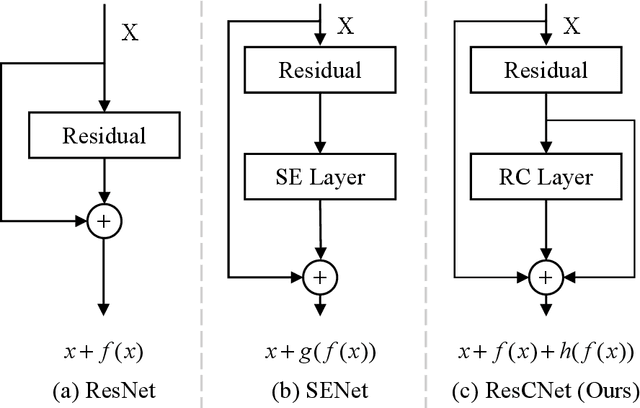


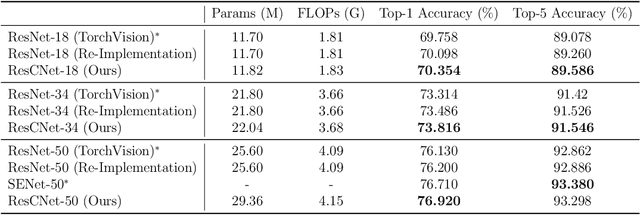
Abstract:Deep neural networks (DNNs) have numerous applications across various domains. Several optimization techniques, such as ResNet and SENet, have been proposed to improve model accuracy. These techniques improve the model performance by adjusting or calibrating feature responses according to a uniform standard. However, they lack the discriminative calibration for different features, thereby introducing limitations in the model output. Therefore, we propose a method that discriminatively calibrates feature responses. The preliminary experimental results indicate that the neural feature response follows a Gaussian distribution. Consequently, we compute confidence values by employing the Gaussian probability density function, and then integrate these values with the original response values. The objective of this integration is to improve the feature discriminability of the neural feature response. Based on the calibration values, we propose a plugin-based calibration module incorporated into a modified ResNet architecture, termed Response Calibration Networks (ResCNet). Extensive experiments on datasets like CIFAR-10, CIFAR-100, SVHN, and ImageNet demonstrate the effectiveness of the proposed approach. The developed code is publicly available at https://github.com/tcmyxc/ResCNet.
Fire and Smoke Detection with Burning Intensity Representation
Oct 22, 2024



Abstract:An effective Fire and Smoke Detection (FSD) and analysis system is of paramount importance due to the destructive potential of fire disasters. However, many existing FSD methods directly employ generic object detection techniques without considering the transparency of fire and smoke, which leads to imprecise localization and reduces detection performance. To address this issue, a new Attentive Fire and Smoke Detection Model (a-FSDM) is proposed. This model not only retains the robust feature extraction and fusion capabilities of conventional detection algorithms but also redesigns the detection head specifically for transparent targets in FSD, termed the Attentive Transparency Detection Head (ATDH). In addition, Burning Intensity (BI) is introduced as a pivotal feature for fire-related downstream risk assessments in traditional FSD methodologies. Extensive experiments on multiple FSD datasets showcase the effectiveness and versatility of the proposed FSD model. The project is available at \href{https://xiaoyihan6.github.io/FSD/}{https://xiaoyihan6.github.io/FSD/}.
Benchmarking Multi-Scene Fire and Smoke Detection
Oct 22, 2024Abstract:The current irregularities in existing public Fire and Smoke Detection (FSD) datasets have become a bottleneck in the advancement of FSD technology. Upon in-depth analysis, we identify the core issue as the lack of standardized dataset construction, uniform evaluation systems, and clear performance benchmarks. To address this issue and drive innovation in FSD technology, we systematically gather diverse resources from public sources to create a more comprehensive and refined FSD benchmark. Additionally, recognizing the inadequate coverage of existing dataset scenes, we strategically expand scenes, relabel, and standardize existing public FSD datasets to ensure accuracy and consistency. We aim to establish a standardized, realistic, unified, and efficient FSD research platform that mirrors real-life scenes closely. Through our efforts, we aim to provide robust support for the breakthrough and development of FSD technology. The project is available at \href{https://xiaoyihan6.github.io/FSD/}{https://xiaoyihan6.github.io/FSD/}.
PruningBench: A Comprehensive Benchmark of Structural Pruning
Jun 18, 2024



Abstract:Structural pruning has emerged as a promising approach for producing more efficient models. Nevertheless, the community suffers from a lack of standardized benchmarks and metrics, leaving the progress in this area not fully comprehended. To fill this gap, we present the first comprehensive benchmark, termed \textit{PruningBench}, for structural pruning. PruningBench showcases the following three characteristics: 1) PruningBench employs a unified and consistent framework for evaluating the effectiveness of diverse structural pruning techniques; 2) PruningBench systematically evaluates 16 existing pruning methods, encompassing a wide array of models (e.g., CNNs and ViTs) and tasks (e.g., classification and detection); 3) PruningBench provides easily implementable interfaces to facilitate the implementation of future pruning methods, and enables the subsequent researchers to incorporate their work into our leaderboards. We provide an online pruning platform http://pruning.vipazoo.cn for customizing pruning tasks and reproducing all results in this paper. Codes will be made publicly available.
 Add to Chrome
Add to Chrome Add to Firefox
Add to Firefox Add to Edge
Add to Edge